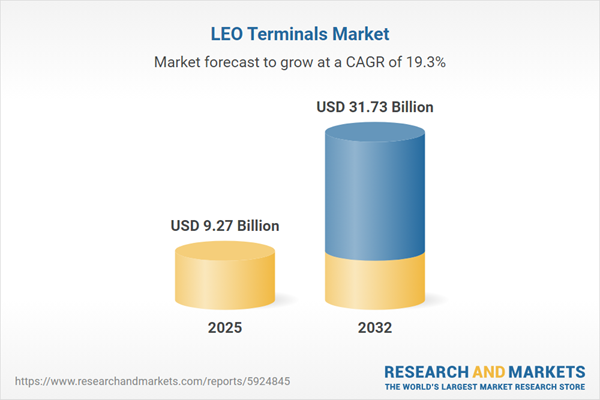Speak directly to the analyst to clarify any post sales queries you may have.
The Low Earth Orbit (LEO) Terminals Market is at a critical inflection point, driven by rapid technology advancements and expanding global connectivity needs among enterprises, governments, and defense stakeholders. This growth demands agile strategies from decision-makers who seek to capitalize on the transformation of satellite communications infrastructure worldwide.
Market Snapshot: LEO Terminals Market Growth Outlook
The LEO terminals market grew from USD 7.75 billion in 2024 to USD 9.27 billion in 2025. Forecasts show continued expansion at a CAGR of 19.26%, with the market anticipated to reach USD 31.73 billion by 2032.
Scope & Segmentation: Low Earth Orbit Terminals
- Terminal Types: Handheld terminals for first responders and field use; large terminals for remote broadband and enterprise backhaul (above one meter, and 0.5 to one meter); medium terminals balancing mobility and performance (below 0.3 meter, and 0.3 to 0.5 meter); small terminals for portable deployment.
- Application Areas: Consumer and enterprise broadband; emergency services; Internet of Things (IoT) including both consumer and industrial use; machine-to-machine (M2M) communication; video streaming applications.
- End User Segments: Commercial operators spanning aviation, maritime, and telecom; government entities such as research institutes and space agencies; military arms including air force, army, and navy.
- Frequency Bands: Ka band (sub-categorized into high and low Ka); Ku band; S band; X band, each addressing specific throughput and coverage requirements.
- Technology Types: Hybrid solutions; electronically steered phased array terminals; reflector-based designs.
- Geographical Regions: Americas (North America, Latin America); Europe, Middle East, and Africa (including key national markets in Western and Eastern Europe, the Gulf states, and Africa); Asia-Pacific (covering East and Southeast Asian countries, India, and Oceania).
Key Takeaways for Senior Decision-Makers
- LEO terminals play a central role in next-generation connectivity, supporting reliable, high-speed data flows across remote and urban environments.
- Stakeholders are adjusting supply chain and go-to-market strategies to address shifting procurement patterns and evolving regional regulations.
- Ongoing advances in antenna design and signal processing have enabled terminals to perform in carriage-on-the-move and challenging operational settings.
- Segmented terminal formats and frequency options allow tailored deployment, enhancing service delivery and operational resilience for enterprises, governments, and defense organizations.
- Interoperability and standardization efforts, spurred by strategic alliances, pave the way for scalable, multi-network deployments.
Assessing Tariff Impact: U.S. Policy and Supply Chain Strategies
Recent U.S. tariff adjustments have impacted procurement costs for critical LEO terminal components such as semiconductor chips and radio-frequency modules. Manufacturers are leveraging strategies including nearshoring, alternative supplier partnerships, and modular product design to sustain competitiveness. These shifts are propelling a focus on supply chain flexibility and cost insulation for end users, underpinning continued investment in research and development for component integration alternatives.
Methodology & Data Sources
The report employs robust research techniques, integrating secondary data reviews, targeted primary interviews, and expert validation. Data triangulation and rigorous cross-verification enhance reliability. Segmentation and regional perspectives are informed by industry engagement, patent filings, and spectrum registries to ensure actionable insights.
Why This Report Matters
- Enables evidence-based decisions on product development, market entry, and capital allocation for LEO terminal initiatives.
- Clarifies evolving technology trends and regional opportunities to inform long-term strategic planning.
- Presents granular segmentation and end-user profiling to support tailored service offerings and relationship building.
Main Industry Participants Profiled
- Space Exploration Technologies Corp.
- Eutelsat OneWeb Ltd.
- Hughes Network Systems, LLC
- Viasat, Inc.
- Gilat Satellite Networks Ltd.
- Intellian Technologies Co., Ltd.
- Kymeta Corporation
- Mynaric AG
- Cobham Limited
- ST Engineering iDirect
Conclusion
The LEO Terminals Market is undergoing accelerated evolution, with product and demand diversity reshaping global connectivity. Senior leaders equipped with this analysis can anticipate shifts and identify opportunities vital to future satellite infrastructure success.
Additional Product Information:
- Purchase of this report includes 1 year online access with quarterly updates.
- This report can be updated on request. Please contact our Customer Experience team using the Ask a Question widget on our website.
Table of Contents
3. Executive Summary
4. Market Overview
7. Cumulative Impact of Artificial Intelligence 2025
Companies Mentioned
The companies profiled in this LEO Terminals market report include:- Space Exploration Technologies Corp.
- Eutelsat OneWeb Ltd.
- Hughes Network Systems, LLC
- Viasat, Inc.
- Gilat Satellite Networks Ltd.
- Intellian Technologies Co., Ltd.
- Kymeta Corporation
- Mynaric AG
- Cobham Limited
- ST Engineering iDirect
Table Information
| Report Attribute | Details |
|---|---|
| No. of Pages | 192 |
| Published | October 2025 |
| Forecast Period | 2025 - 2032 |
| Estimated Market Value ( USD | $ 9.27 Billion |
| Forecasted Market Value ( USD | $ 31.73 Billion |
| Compound Annual Growth Rate | 19.2% |
| Regions Covered | Global |
| No. of Companies Mentioned | 11 |









